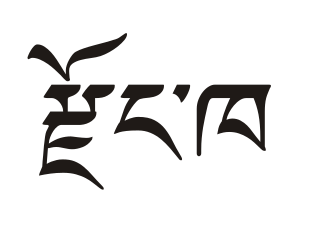
Dzongkha is a Tibeto-Burman language that is the official and national language of Bhutan. It is written using the Tibetan script.

Mongar District is one of the 20 dzongkhags (districts) comprising Bhutan. Mongar is the fastest-developing dzongkhag in eastern Bhutan. A regional hospital has been constructed and the region is bustling with many economic activities. Mongar is noted for its lemon grass, a plant that can be used to produce an essential oil. It also has a hydroelectric power-plant on the Kuri Chhu river. Mongar is notable for having the longest work time in all the dzongkhags of Bhutan.
The Mahakiranti or Maha-Kiranti languages are a proposed intermediate level of classification of the Sino-Tibetan languages, consisting of the Kiranti languages and neighbouring languages thought to be closely related to them. Researchers disagree on which languages belong in Mahakiranti, or even whether Mahakiranti is a valid group. The group was originally proposed by George van Driem, who retracted his proposal in 2004 after a field study in Bhutan.
The Sharchops are the populations of mixed Tibetan, Southeast Asian and South Asian descent that mostly live in the eastern districts of Bhutan.
Tshangla is a Sino-Tibetan language of the Bodish branch closely related to the Tibetic languages. Tshangla is primarily spoken in Eastern Bhutan and acts as a lingua franca in the region; it is also spoken in the adjoining Tawang tract in the Indian state of Arunachal Pradesh and the Pemako region of Tibet. Tshangla is the principal pre-Tibetan language of Bhutan.

George "Sjors" van Driem is a Dutch professor emeritus of linguistics at the University of Bern. He studied East Asian languages and is known for the father tongue hypothesis.
Numerous ethnic groups inhabit Bhutan, but the Ngalop people who speak the Dzongkha language constitute a majority of the Bhutanese population. The Bhutanese are of four main ethnic groups, which themselves are not necessarily exclusive – the politically and culturally dominant Ngalop of western and northern Bhutan, the Sharchop of eastern Bhutan, the Lhotshampa concentrated in southern Bhutan, and Bhutanese tribal and aboriginal peoples living in villages scattered throughout Bhutan.

There are two dozen languages of Bhutan, all members of the Tibeto-Burman language family except for Nepali, which is an Indo-Aryan language, and the Bhutanese Sign Language. Dzongkha, the national language, is the only native language of Bhutan with a literary tradition, though Lepcha and Nepali are literary languages in other countries. Other non-Bhutanese minority languages are also spoken along Bhutan's borders and among the primarily Nepali-speaking Lhotshampa community in South and East Bhutan. Chöke is the language of the traditional literature and learning of the Buddhist monastics.

The following outline is provided as an overview of and topical guide to Bhutan:
The Khengkha language, or Kheng, is an East Bodish language spoken by ~40,000 native speakers worldwide, in the Zhemgang, Trongsa, and Mongar districts of south–central Bhutan.
Bodish, named for the Tibetan ethnonym Bod, is a proposed grouping consisting of the Tibetic languages and associated Sino-Tibetan languages spoken in Tibet, North India, Nepal, Bhutan, and North Pakistan. It has not been demonstrated that all these languages form a clade, characterized by shared innovations, within Sino-Tibetan.
The East Bodish languages are a small group of non-Tibetic Bodish languages spoken in eastern Bhutan and adjacent areas of Tibet and India. They include:

The Tibeto-Burman languages are the non-Sinitic members of the Sino-Tibetan language family, over 400 of which are spoken throughout the Southeast Asian Massif ("Zomia") as well as parts of East Asia and South Asia. Around 60 million people speak Tibeto-Burman languages. The name derives from the most widely spoken of these languages, Burmese and the Tibetic languages, which also have extensive literary traditions, dating from the 12th and 7th centuries respectively. Most of the other languages are spoken by much smaller communities, and many of them have not been described in detail.
Lhokpu, also Lhobikha or Taba-Damtoe-Bikha, is one of the autochthonous languages of Bhutan spoken by the Lhop people. It is spoken in southwestern Bhutan along the border of Samtse and Chukha Districts. Van Driem (2003) leaves it unclassified as a separate branch within the Sino-Tibetan language family.
The Dzala language, also called Dzalakha, Dzalamat, or Yangtsebikha, is an East Bodish language spoken in eastern Bhutan, in the Lhuntse and Trashiyangtse Districts.

ʼOle, also called ʼOlekha or Black Mountain Monpa, is a moribund, possibly Sino-Tibetan language spoken natively by 1 person in the Black Mountains of Wangdue Phodrang and Trongsa Districts in western Bhutan. The term ʼOle refers to a clan of speakers.
The Brokpa language (Brokpa: Brokpakæ; Dzongkha: དྲོག་པ་ཁ།, དྲོགཔ་ཁ།) is a Tibetic language spoken by around 5,000 people. It is spoken by descendants of pastoral yakherd communities.

The Bumthang language ; also called "Bhumtam", "Bumtang(kha)", "Bumtanp", "Bumthapkha", and "Kebumtamp") is an East Bodish language spoken by about 20,000 people in Bumthang and surrounding districts of Bhutan. Van Driem (1993) describes Bumthang as the dominant language of central Bhutan.

The Takpa or Dakpa language, Dakpakha, known in India as Tawang Monpa, also known as Brami in Bhutan, is an East Bodish language spoken in the Tawang district of Arunachal Pradesh, and in northern Trashigang District in eastern Bhutan, mainly in Kyaleng, Phongmed Gewog, Dangpholeng and Lengkhar near Radi Gewog. Van Driem (2001) describes Takpa as the most divergent of Bhutan's East Bodish languages, though it shares many similarities with Bumthang. SIL reports that Takpa may be a dialect of the Brokpa language and that it been influenced by the Dzala language whereas Brokpa has not.
Laya is a Tibetic variety spoken by indigenous Layaps inhabiting the high mountains of northwest Bhutan in the village of Laya, Gasa District. Speakers also inhabit the northern regions of Thimphu and Punakha Districts. Its speakers are ethnically related to the Tibetans. Most speakers live at an altitude of 3,850 metres (12,630 ft), just below the Tsendagang peak. Laya speakers are also called Bjop by the Bhutanese, sometimes considered a condescending term. There were 1,100 speakers of Laya in 2003.










